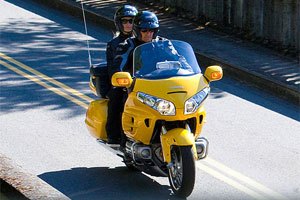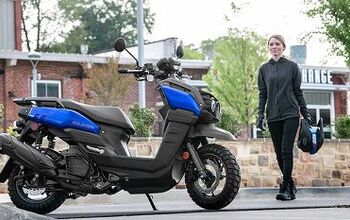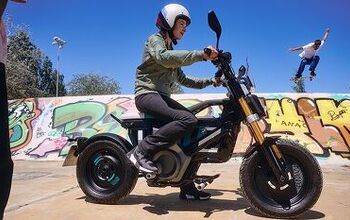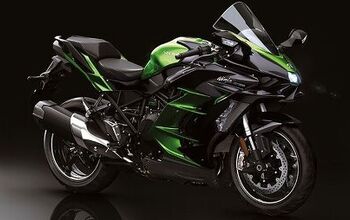Riding With a Passenger
Note: This article alternately refers to both male and female gender to describe riders or passengers in various circumstances. These selections were arbitrary and could apply to either gender.
Riding with a passenger on your motorcycle can be a lot of fun, but it is something that also ought to involve a fair amount of thought and care.
The minute you offer a person a ride, you’ve just accepted the job of controlling your bike at an operational disadvantage, and the responsibility of preserving another human life.
| Allstate Insurance On Rider Safety |
Our friends at Allstate Motorcycle Insurance know a thing or two about motorcycle safety. In addition to Motorcycle.com's safety series, Allstate Motorcycle Insurance has its own valuable safety information to share. * Motorcycle Awareness: Safety Tips from Allstate Motorcycle Insurance |
Depending on the weight of your passenger, the bike will handle anywhere from feeling somewhat weighted to absolutely sluggish. With increased mass to manage, and the center of gravity shifted rearward and higher, braking is also affected.
And beyond these considerations, a lot of trust needs to be in place all around. Do you trust your skills? Are you up to the task of competently handling the machine with your intended passenger? And as a word to potential passengers: if someone offers you a ride, ask yourself whether you trust him. How well do you know him? Does he have a motorcycle operator’s license? Do you believe he is a good rider who will be safe?
Notwithstanding these kinds of questions, riders have been accepting passengers since motorcycles started offering seating for two and probably before that. In the U.S. today, only about 20 out of 50 states have universal mandatory helmet laws, and none have much in the way of personal safety gear requirements. So in reality, on any given day you may see a lot of different levels of preparation.
Depending on your risk tolerance and definition of personal responsibility, the following are some basics of riding two-up in the safest and most ethical way:
Communication
If your passenger is a newbie, you need to instruct him what gets hot, where to place his feet, how to get on and off the bike, where to hold on, and how to sit.
He should be prepped to remain passively in place, holding on, not putting feet down at stops, and most importantly, not try to “help” by leaning with or against you when on the road. He should just ride in line and relax, letting you control the bike. Some riding instructors liken the ideal passenger to a “sack of potatoes glued to the seat” whose job is to not make his presence felt any more than necessary.
But before you even get going, you might also want to work out some means of mutually understood communication. For example, you could agree that a shoulder tap or a certain number of taps could mean, “Please slow down,” or “I need to ask you something,” etc. Or pointing to the side of the road could indicate, “Please pull over,” or “I need to take a break.”
You should encourage your passenger to be open with you, let you know how she feels, and do what it takes to reassure her. There have been many potential co-riders scared away from ever riding again when given a thrill ride as their rite of initiation. Perhaps the best way to start with a new passenger is “nice and easy.”
The enlightened way to break in a new passenger is to cater to her level of experience, sensitivity to fear, and how well you know each other. Taking her on a comfortably paced ride in less threatening environs with nicer scenery is the preferred method for starting new riders off with good experiences they’ll want to repeat. Asking how she’s doing at intervals is also usually appreciated, and goes a long way to building trust.
And lastly, you both should learn not to clack helmets when accelerating or braking, assuming you are wearing them, which of course you know is preferable.
Gear
If a person is willing to trust you with her life and safety, it is your job to prove her trust is well founded and put her well being at least equally, if not over and above yours.
Your life is yours to risk, but no one has the right to recklessly endanger another person’s. If she doesn’t really have a sense of all the risks involved, or even if she tells you she is not concerned, this is a situational judgment call, but it is recommended you insist she gear up anyway.
It’s your bike, and you set the standards for you and your passenger. Even if the law says you don’t have to, offering gear is your way of showing that you are looking out for her, and take your responsibility seriously.
If she doesn’t have her own helmet, giving her one with eye protection is minimum. Make sure it fits. For example, it should not be so loose that it could fly off in a crash. An abrasion-resistant – preferably armored – jacket, long pants with the same crashworthiness as the jacket, over-the-ankle boots and definitely gloves are also recommended.
Most likely she’ll have her own jeans and boots. When assessing safety apparel, riders often give dungarees a wink and a nod as OK, but in reality a crash would grind though denim in under a second. If you have a pair of riding pants that would even loosely fit her, you may offer these as over pants, telling her you want to make sure she’s as safe as can be.
If you don’t have a riding jacket to offer her, and she doesn’t have anything roadworthy herself, you may want to offer her yours if possible, and go to plan B for yourself.
Ideally, having a spare helmet and apparel for passengers is the way to go, and if they are going to ride with you regularly, they should invest in proper fitting gear.
Bike
Naturally, your bike should be in good condition – tires with decent tread, and sufficiently inflated for the heavier load. Increasing the rear suspension preload is also usually required for the extra weight. And it may even be a good idea to up the front preload to compensate for braking forces, depending on the weight of your rider, and your particular bike. If not sure how to do this, check your owner’s manual or ask a dealer or independent repair facility for advice for your bike and intended passenger’s weight.
Starting off “nice and easy” is a good idea not only for your passenger, but also for you. Re-learning to take corners and brake with skill takes practice and sensitivity. With added weight on the rear wheel, you may find you have better traction to let you use the rear brake more than when riding solo (assuming you have separate front and rear brake circuits). Overall, however, your heavier bike may or may not be able to stop as quickly.
With the plethora of motorcycle styles and displacements now available, the suitability of different bikes to handle passengers can vary widely, and present diverse factors to consider on a case-by-case basis.
Touring bikes are made for passengers. They have wider, comfortable saddles, and places to hold onto. Some cruisers may be pretty good too, especially those with passenger-accommodating accessories.
It is at least worth noting that a back rest, or the like, is great for helping a passenger stay put and feel secure, but if you went down, it might make it harder for your passenger to as quickly get off the falling bike.
Dual-purpose bikes may be so-so as passenger conveyances, and as for most modern sportbikes, being the thinly disguised race bikes that they are, passenger accommodations are really an afterthought.
A seat strap is not a functional safety device. If there are no handholds, the only safe place to really hold onto is your waist. Hopefully you two are good friends. If there is any aversion to wanting to hold on to the rider, holding behind the seat does not even count as second best. If your passenger wants to do this, you better not accelerate anywhere near as hard or suddenly as you could, or he could slide off the back.
Conclusion
Just as it takes time to learn to ride in the first place, getting really good with a second person takes preparation and practice. Even highly skilled riders need time to work out a rhythm with their passenger.
Two-up riding can be a great experience for both rider and passenger, but taking it seriously, and doing it right is the best way to make sure that it is.
Related Reading
How Well Do You Know Your Motorcycle?
Rider Education, Injuries and Fatalities
What to Wear When You Ride - and Why
The SEE System: Increasing Your Visibility
Motorcycle Insurance Basics
Choose a Motorcycle That Fits
The American Culture of Motorcycle Safety
Group Riding 101
Should You Ride a Motorcycle?
How to Load Your Motorcycle
Night Riding
Riding in the Rain and Wind
The Truth about Drinking and Riding
Road Conditions Quiz
Knowing How to Brake Saves (the most) Lives
More by Jeff Cobb































Comments
Join the conversation